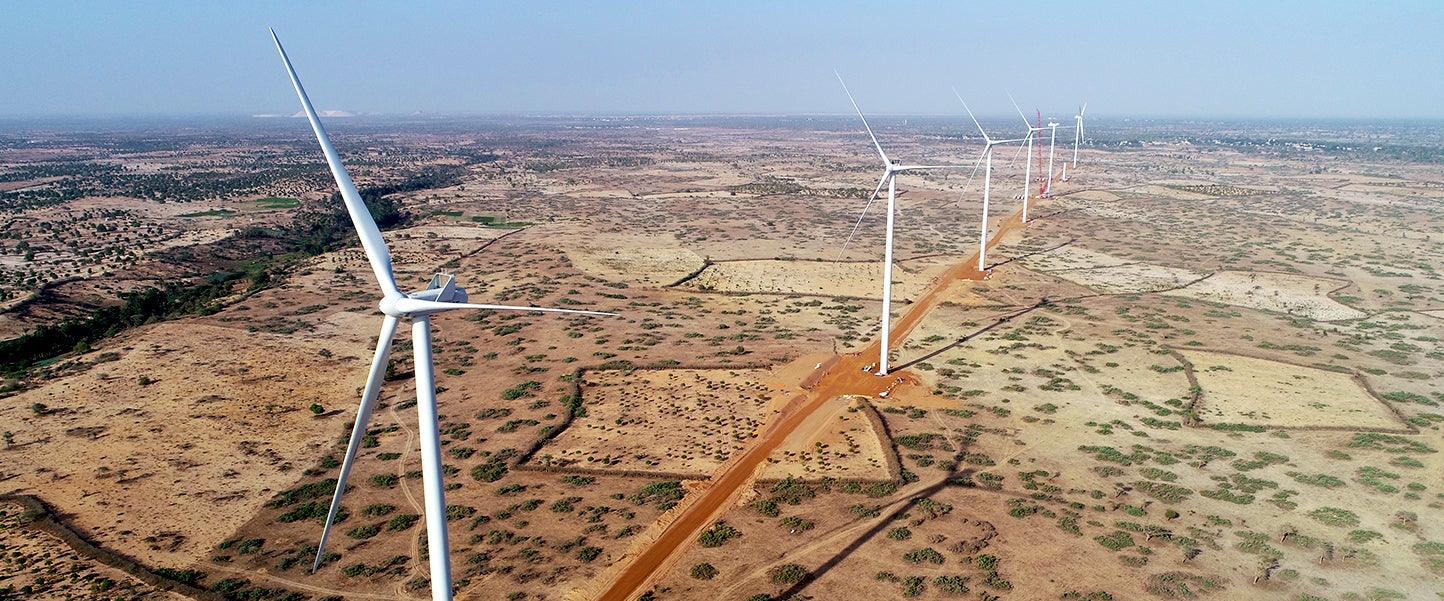 Senegal wind farm/ Photo: MIGA
Senegal wind farm/ Photo: MIGA
Modern onshore wind turbines — some standing over 160 meters tall — are a common sight in many countries, providing power to tens of millions of households and jobs to millions of workers. Yet wind turbines are a rare sight in Africa, a continent with enormous energy needs and significant wind potential.
While COVID-19 has had considerable adverse impacts on African economies, the World Bank projects economic growth of 2.3—3.4 percent across Sub-Saharan Africa this year. To support sustained growth, the region will need, clean, affordable and reliable power generation, which points to a big role for solar and wind energy.
Wind power is showing its potential. According to the Global Wind Energy Council (GWEC), a record 93 GW of new wind capacity was added worldwide in 2020. GWEC estimates that 469 GW of new wind power capacity will be installed over the next five years, globally.
Despite this global growth, Africa accounts for less than 1 percent of global installed wind capacity. Nonetheless, there are reasons to be optimistic about the opportunity for wind development in Africa as recent studies speak to more wind resources being available for wind generation in many more countries in Africa than previously thought.
IFC commissioned a study last year to assess the potential for wind power in Africa and found that it possesses an astonishing technical wind potential of almost 180,000 terawatt hours (TWh) per year — enough to satisfy the entire continent’s electricity demands 250 times over. Commercial or practical wind potential would be much less, subject to technical, financial, environmental, and social constraints. Even more exciting, the study found that two thirds of Africa’s total wind potential is located in places with average wind speeds over 7.5 metres per second. That is a sweet spot as far as optimal wind conditions for turbines are concerned.
A study to assess the potential for wind power found that Africa "possesses an astonishing technical wind potential of almost 180,000 terawatt hours (TWh) per year — enough to satisfy the entire continent’s electricity demands 250 times over."
Why is it only now that we’re realizing Africa’s remarkable wind potential? Part of the answer lies in the turbines themselves. Advances in technology, combined with manufacturing economies of scale, mean that turbines are much better able to capture wind productively in sites where wind speeds would have been considered too low just five years ago.
Another part of the answer lies in our ability to “see” pockets of good wind potential using high-resolution, cloud-computing based models. These models are able to estimate wind speeds in a 100 meter by 100 meter square area anywhere on the planet with a high degree of accuracy. This is a resolution nearly 1,000 times better than computer models were able to generate just five years ago.
One big surprise of our study was what the results revealed about the wide geographical distribution of wind potential. The study found pockets of potential in places that had rarely been talked about as having much, or any, wind potential. Those places include areas in Namibia, Botswana, Cote d’Ivoire, Cameroon, Mauritania, Madagascar and Tunisia. In many cases, the best wind resources are in areas close to demand centres, such as towns and cities. Moreover, in many of these areas the wind blows strongest in the early evening and early morning when electricity demand is highest. This makes wind a perfect complement to solar, which generates most of its power during the daytime.
Despite this potential there are significant challenges, as IFC has learned over the past ten years through investments in 67 wind projects around the world representing over 4,500 MW of new capacity. These challenges include lack of familiarity at the country level with wind technology, macroeconomic and sector conditions that make it difficult to access financing to develop wind initiatives, and connectivity logistics to link wind power with transmission lines.
We also know that building out Africa’s wind potential means putting turbines in the right places where they will benefit communities and not adversely impact regional biodiversity. This is why IFC brought Everoze and The Biodiversity Consultancy together to identify areas that might be particularly vulnerable to such negative impacts, such as protected and internationally recognized areas for biodiversity, important bird migratory corridors, known vulture/raptor nesting sites, and community conservation areas, and to exclude these areas from further consideration.
It is also why we’re looking to engage with local communities to create opportunities for benefit-sharing from wind projects. IFC has been working closely with developers to facilitate local community benefit-sharing from wind and solar projects.
Africa’s wind potential presents a significant opportunity and challenge for private sector involvement, and for IFC as we work with partners to identify bankable, sustainable projects.
We look forward to building on over a decade of investing in wind projects globally, to help address the wind power deficit in Africa and have a real impact on the continent’s sustainable development. We plan to scale up wind generation by bringing together a suite of World Bank Group services under a single engagement aimed at creating viable markets for Scaling Wind power in emerging markets—with an initial focus on Africa.



Join the Conversation